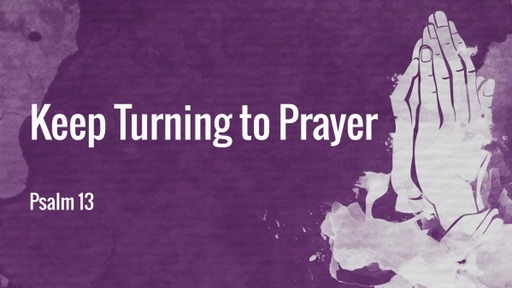Keep Turning to Prayer

Notes
Transcript
To the choirmaster. A Psalm of David.
1 How long, O Lord? Will you forget me forever? How long will you hide your face from me?
2 How long must I take counsel in my soul and have sorrow in my heart all the day? How long shall my enemy be exalted over me?
3 Consider and answer me, O Lord my God; light up my eyes, lest I sleep the sleep of death,
4 lest my enemy say, “I have prevailed over him,” lest my foes rejoice because I am shaken.
5 But I have trusted in your steadfast love; my heart shall rejoice in your salvation.
6 I will sing to the Lord, because he has dealt bountifully with me.
Lament is the honest cry of a hurting heart wrestling with the paradox of pain and the promise of God’s goodness (p. 26).
Christians affirm that the world is broken, God is powerful, and he will be faithful. Therefore, lament stands in the gap between pain and promise (p. 26).
You might think lament is the opposite of praise. It isn’t. Instead, lament is a path to praise as we are led through our brokenness and disappointment. 6 The space between brokenness and God’s mercy is where this song is sung. Think of lament as the transition between pain and promise. It is the path from heartbreak to hope (p. 28-29).
This poetic odyssey usually includes four key elements: (1) an address to God, (2) a complaint, (3) a request, and (4) an expression of trust and/ or praise. 7 For the purposes in this book, I’ll use four words to help us learn to lament: turn, complain, ask, and trust (p. 29).
It takes faith to pray a lament. To pray in pain, even with its messy struggle and tough questions, is an act of faith where we open up our hearts to God. Prayerful lament is better than silence (p. 31).
Honest, humble, pain-filled questions are part of what it means to be a follower of Jesus. ....lament is humbly turning to God through the pain. It takes faith to lay our painful questions before the Lord. Anyone can cry, but it takes faith to turn to God in lament (p. 34).
Lament is how we learn to live between the poles of a hard life and God’s goodness. It is an opportunity to remind our hearts about God’s faithfulness in the past, especially when the immediate events of life are overwhelmingly negative. While we’re still in pain, lament reminds our hearts of what we believe to be true (p. 36).
Tears are part of what it means to behuman. But to lament is Christian. It is a prayer of faith for the journey between a hard life and God’s goodness. We need to learn to lament. Through the tears, the first step is to turn to God in prayer.
1. In your own words, what makes lament Christian? Why does it take faith to lament?
2. Describe a time when you found it difficult to pray because you were suffering. What were the circumstances or the reasons for your silence?
3. What are some of the hard and painful questions that you’ve asked God over the years?
4. As you think back on God’s faithfulness, where has he proven himself to be trustworthy?
5. What portions of Scripture do you use to anchor your soul to who God is?
6. How is lament connected to your theology?
7. How does the cross become the ultimate anchor and resolution for our suffering and pain?
8. Take a few minutes and talk to God about whatever is in your soul as you conclude this chapter. Tell him your pain, share your questions, affirm your trust, and ask him to keep you trusting.
Vroegop, Mark. Dark Clouds, Deep Mercy (pp. 38-40). Crossway. Kindle Edition.